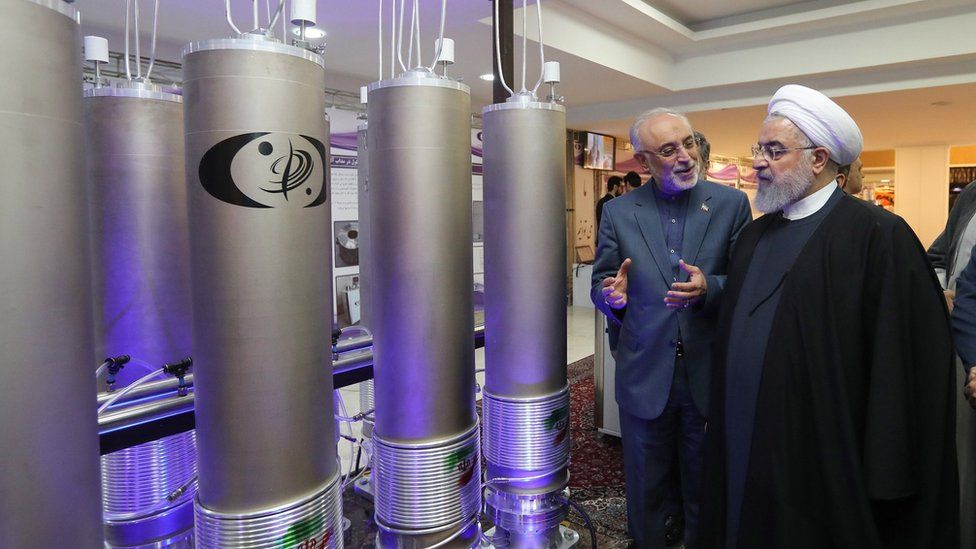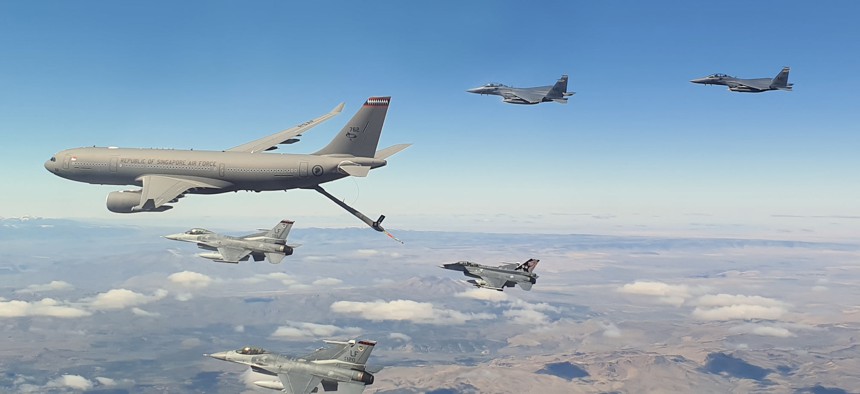Israel Prepares for Military Option Against Iran
Israel Air Force engineers have successfully modified its fleet of F-35s, making a massive aerial strike on Iran possible now
 Israeli
F-35s have reportedly been modified to enable a strike on Iran without
the need for mid-flight refueling, making the military option far more
viable
Israeli
F-35s have reportedly been modified to enable a strike on Iran without
the need for mid-flight refueling, making the military option far more
viable
Last week it became clear that international patience with Iran over its nuclear program is running out.
This feeling emerged from a meeting of the members of the International Atomic Energy Agency (IAEA) in Vienna.
The governors of 70 IAEA member countries voted in favor of a resolution censuring Iran for its lack of cooperation with the agency.
Only China and Russia voted against the resolution, the first to censure Iran since 2020 when IAEA governors also condemned the Islamic Republic for lack of cooperation with the UN nuclear watchdog.
A few weeks later, Iran backed down and gave the IAEA access to nuclear facilities it wanted to investigate.
 President Hassan Rouhani (R) is shown some of the centrifuges at an Iranian nuclear facility by Ali Salehi, head of the Atomic Energy Organization of Iran
President Hassan Rouhani (R) is shown some of the centrifuges at an Iranian nuclear facility by Ali Salehi, head of the Atomic Energy Organization of Iran New IAEA report
Earlier this month, the IAEA released a report showing that Iran has still not explained how particles of nuclear material were present in three previously undeclared facilities when IAEA inspectors were finally allowed to visit these sites.
This shows that Iran is still lying about its nuclear program, as Israeli Prime Minister Naftali Bennett also noted when he revealed 10 days ago that the regime had stolen classified IAEA reports in the past.
IAEA Director General Rafael Grossi wrote in his latest report that “Iran had not provided an explanation that was technically credible in light of the agency’s findings.”
Last week, the IAEA also warned last that Iran is in the process of installing hundreds of new IR-6 centrifuges at its underground Natanz uranium enrichment plant.
This new activity will bring Iran even faster to the so-called ‘breakout capacity,’ and from there it’s only a matter of time before the Islamic Republic will be able to produce a nuclear warhead that it can mount on one of its long-range missiles.
The Islamic Republic has already enriched enough uranium up to the 60 percent mark to make a crude atomic bomb, nuclear experts say.
The further enrichment of Iran’s uranium hexafluoride gas to the required 90 percent takes only a few weeks.
After that, Iran will theoretically need a maximum of two years to produce a nuclear warhead and mount it on a long-range missile. In theory, because it has been revealed before Iran has had a chance to secretly test detonators for a nuclear device (Parchin).
Iran responded to the IAEA condemnation by shutting down two cameras that recorded nuclear activities and informed the IAEA that it would soon remove up to 27 IAEA cameras.
When that happens, the IAEA will no longer be able to monitor the Islamic Republic’s nuclear program and that will be “the fatal blow” to the 2015 nuclear agreement, according to Grossi.
All of this shows that the regime in Tehran is no longer interested in reaching a new or revised nuclear deal with the six world powers that signed the previous accord (JCPOA) with Iran in 2015.

Israeli response
Bennett’s government responded positively to the IAEA’s decision to censure Iran for its lack of cooperation with the Agency in Vienna.
The Israeli leader said he still hopes the international community will resolve the Iran problem through diplomatic channels by bringing the issue to the UN Security Council.
However, the prime minister has also repeatedly said that the government in Jerusalem reserves the right to independently end Iran’s nuclear program.
That this is not an empty threat is becoming increasingly clear from what the Israeli military apparatus is currently doing.
Both the Israel Defense Forces (IDF) and the Israeli Air Force (IAF) are now actively preparing for a major confrontation with Iran and the bombing of nuclear facilities in the Islamic Republic.
Israel’s F-35s prepared for an attack on Iran
On Thursday, it was announced that IAF engineers have succeeded in designing a system that eliminates the need to refuel its F-35 Adir stealth fighter jet mid-mission.
The F-35 is a radar-invisible warplane that reportedly will be used in a future massive IAF air strike against Iran’s nuclear facilities.

Israel had earlier this year asked the US government for accelerated delivery of a modern tanker aircraft capable of refueling the F-35s mid-air, but the administration of President Joe Biden refused to comply with this request.
IAF engineers have also succeeded in placing a 1,000 kg bomb in the body of the thirty-six F-35s available to the Israeli Air Force.
In this way, the F-35 remains invisible on the radar during a future bombardment of Iran’s nuclear facilities.

Other preparations and new Massad actions
That such a bombardment could now become a reality was also shown by a massive air exercise by IAF aircraft over the Mediterranean one and a half weeks ago.
Hundreds of IAF aircraft took part in this exercise, and the government in Jerusalem said the exercise was intended to simulate a multiple-front war with Iran.
Israel’s foreign secret service Mossad, meanwhile, continues unperturbed with its activities within Iran.
While the Israeli military prepared for an attack on Iran, a key engineer working to expand Iran’s aerial attack capabilities was liquidated.
The engineer, Ayoob Entezari, an expert on drone technology, died of food poisoning after attending a celebratory meal and was later declared a “martyr” by local government officials.
The dinner’s host fled after Entezari’s death to an undisclosed Middle Eastern country.
Mossad was, furthermore, also reportedly responsible for a quadcopter attack on the Parchin military base during the same period.
In that attack, a facility producing unmanned aerial attack vehicles was destroyed. One Iranian engineer was killed during the drone attack.
In Parchin, according to Israel and the IAEA, Iran has previously tested detonators for a nuclear warhead.

Anti-Iran coalition
Israel is also secretly trying to strengthen and expand the anti-Iran coalition with Arab countries.
The Gulf countries with which Israel signed peace agreements in 2020 already have Israeli radar and air defense systems.
The IDF and Mossad reportedly also have a base in Bahrain, one of Israel’s new peace partners, and this has given Israel another chance to operate closer to the borders of Iran.
It had already become clear earlier that Mossad was operating from Azerbaijan’s territory and that there are intensive contacts between the IDF and the army of this predominantly Muslim country.
Meanwhile, secret contacts between Israel and Saudi Arabia are also ramping up under the renewed leadership of the United States, while Bennett made a surprise trip to Abu Dhabi on Thursday last week.
All this has to do with the increasing likelihood that military action will be taken against Iran.
The US itself is not about to take military action against Iran’s nuclear program, but is supporting Israel in various ways in preparing for what has always been called “the military option.”
As for the Iranian entrenchment in Syria, things are heating up there as well.
Over the last week, the Israeli military carried out three attacks against Iranian facilities and Hezbollah’s attempt to set up camp near the Israeli border on the Golan Heights.
Two aerial attacks were carried out from Israeli territory on the northern Golan Heights, while on Tuesday last week, IDF tanks shot at Syrian and Hezbollah positions in the demilitarized zone near Kuneitra on the Syrian Golan Heights.
The IAF bombarded again Iranian facilities near Damascus International Airport killing at least five members of the IRGC.
Satellite photos taken after the second strike in the early hours of last Friday showed three craters in the runway of the airport near Damascus.
The airport was forced to close down after the IAF strike that clearly was intended to halt Iranian weapon transports to Syria and Hezbollah.
The latest Israeli action against Iran in Syria led to a sharp condemnation by the Russian government of President Vladimir Putin and could have repercussions for the already tense relations between Moscow and Jerusalem.
2 comments:
Yep, sounds to me like the Israelis are getting ready to kick some goat fucker ass. I wonder how the hell they managed to increase the fuel capacity AND move the bomb load inside? Any external fuel tanks would certainly degrade the stealth capability I would think (based on my massive training and background in designing stealth aircraft, which is in reality zero).
Food goes bad quickly in the desert.
Post a Comment